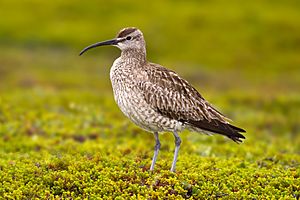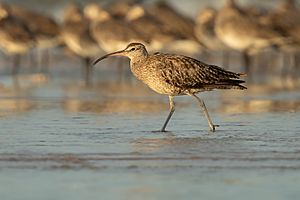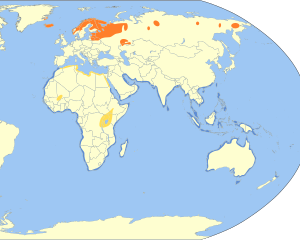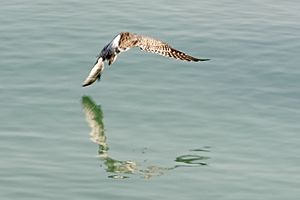Eurasian whimbrel facts for kids
Quick facts for kids Eurasian whimbrel |
|
|---|---|
 |
|
| N. p. phaeopus | |
 |
|
| N. p. variegatus | |
| Conservation status | |
| Scientific classification | |
 |
|
| Eurasian whimbrel range Breeding Migration Non-breeding | |
| Synonyms | |
|
The Eurasian or common whimbrel (Numenius phaeopus) is a cool wader bird. It's part of a big bird family called Scolopacidae. You might also hear it called the white-rumped whimbrel in North America. This bird is one of the most common curlews, which are known for their long, curved beaks. Whimbrels breed in many cold northern parts of Asia and Europe, even as far south as Scotland. Recently, scientists decided that the Eurasian whimbrel and the Hudsonian whimbrel are actually two different species, even though they look very similar!
Contents
About the Whimbrel's Name
The Eurasian whimbrel got its official name from a Swedish scientist named Carl Linnaeus in 1758. He first called it Scolopax phaeopus. Now, it's grouped with other curlews in the genus Numenius. This name comes from an old Greek word for a bird with a crescent-shaped bill, like the moon. The word phaeopus means "dusky foot" in Latin. The English name "whimbrel" sounds like the bird's call!
Whimbrel Subspecies Around the World
There are five types, or subspecies, of the Eurasian whimbrel:
- N. p. islandicus: These birds breed mainly in Iceland, but also in Greenland, the Faroe Islands, and Scotland. They spend their winters mostly in West Africa.
- N. p. phaeopus (European whimbrel): This is the main type. They breed from Norway to north central Siberia. They fly to Africa and parts of Asia for winter.
- N. p. alboaxillaris: These whimbrels breed from western Kazakhstan to southwestern Siberia. They are quite rare and endangered. They winter in south and east Asia.
- N. p. rogachevae: These birds breed in north central Siberia. They spend winter in east Africa and west India.
- N. p. variegatus: They breed in northeastern Siberia. They fly all the way to India and Australia for the winter.
Eurasian vs. Hudsonian Whimbrel
The Hudsonian curlew (Numenius hudsonicus) used to be thought of as the same species as the Eurasian whimbrel. But scientists found differences in their genes and feathers. So, now they are considered two separate species.
Spotting the Difference: Eurasian vs. Hudsonian Whimbrel
For a long time, people thought whimbrels were one big group, breeding in Russia and Canada, then flying to coasts worldwide for winter. However, the whimbrels in North America seemed a bit different. In 2020, scientists officially recognized them as a separate species. The North American birds are now called Numenius hudsonicus.

At first glance, these two types of whimbrels look very similar. But there are a few key ways to tell them apart. The Hudsonian whimbrel (from the New World) looks a bit more "faded." The biggest difference is on their lower back, called the rump. Eurasian whimbrels have a mostly white rump, which you can easily see when they fly. Hudsonian whimbrels have a rump that's a similar dull brown color to the rest of their body, with dark stripes.
So, if a Eurasian whimbrel visits North America, people might call it a "white-rumped whimbrel." And if a Hudsonian whimbrel visits Europe, it might be called a "Hudsonian whimbrel." But if you know where they are, both can simply be called a whimbrel!
What Does a Whimbrel Look Like?
The Eurasian whimbrel is a fairly large wader bird. It's about 37 to 47 centimeters (14.5 to 18.5 inches) long. Its wingspan can be 75 to 90 centimeters (29.5 to 35.5 inches). It weighs between 270 and 493 grams (9.5 to 17.4 ounces).
It's mostly grayish-brown. Many Eurasian whimbrels have a white back and rump. They have a long, curved beak that has a slight bend, not a smooth curve. Their usual call is a rippling whistle. When they sing, it becomes a longer trill.
The only other common birds that look similar are larger curlews. Whimbrels are smaller than those curlews. They also have a shorter, downward-curved bill. You can spot them by the stripe down the middle of their head and strong stripes above their eyes.
Where Whimbrels Live and Travel
The whimbrel is a migratory bird. This means it travels long distances. They spend their winters on coasts in Africa, South Asia, and Australasia. During their migration, they also stick to coastal areas. They often gather in groups when they are not breeding. You can find them in Ireland and the United Kingdom. They breed in Scotland, especially around Shetland, Orkney, and the Outer Hebrides. They also breed on the mainland in Sutherland and Caithness.
Whimbrel Life and Habits
Reproduction and Nesting
Whimbrels make their nests on tundra or Arctic moorland. Their nest is just a simple scrape on the ground. They usually lay three to five eggs. Adult whimbrels are very protective of their nesting areas. They will even try to scare away humans who come too close!
What Whimbrels Eat
These birds find their food by poking their long beaks into soft mud. They look for small invertebrates like worms. They also pick up small crabs and similar prey from the surface. Before they migrate, berries become a very important part of their diet. Sometimes, they have even been seen eating insects, like blue tiger butterflies.
Protecting the Whimbrel
The whimbrel is part of an important agreement called the Agreement on the Conservation of African-Eurasian Migratory Waterbirds. This agreement helps protect birds that migrate across Africa and Eurasia.
Towards the end of the 1800s, a lot of whimbrels were hunted during their migration. This caused their numbers to drop a lot. Luckily, their population has recovered since then. The whimbrel is currently listed as a Least Concern species on the IUCN Red List. This means they are not in immediate danger of disappearing. However, they are still affected by things like climate change, losing their natural homes, and outbreaks of Avian flu, which they can catch.
See also
 In Spanish: Zarapito trinador para niños
In Spanish: Zarapito trinador para niños



